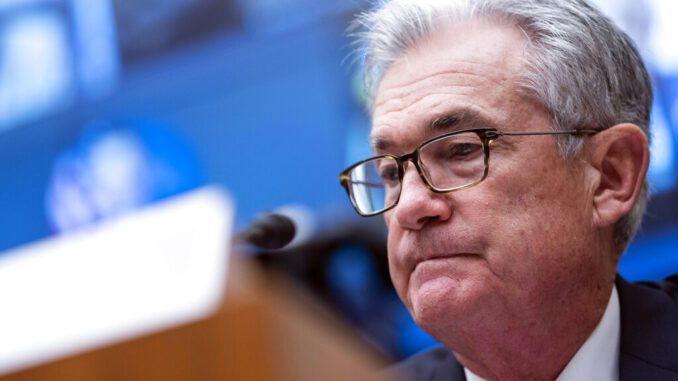
The rate of inflation in the U.S. is at its highest level in three decades, breaking a long stretch of modest pressure that predates the service of most national policymakers (with some notable exceptions, of course). Fortunately, the staff running the Penn Wharton Budget Model (PWBM) have provided a timely and accessible refresher for the uninitiated of what it could all mean. Their modeling is a useful reminder that price stability should never be taken for granted.
The inflation environment was shifting even before Congress passed the highly stimulative $1.8 trillion COVID response bill in March 2021. Last year, Federal Reserve Chairman Jerome Powell engineered a modest loosening in inflation targeting by announcing that periods of average price-rises below the 2.0% target could be offset, temporarily, by inflation above the target. The goal is now a multi-year average that is close to the agreed-upon objective. It was adopted in response to the sustained spell of very low inflation that followed the 2008-2009 financial crisis.
A main concern during those years was deflation and the difficulty of spurring growth when interest rates are already near zero. If inflation is persistently low, and the economy falls into a recession, there is a risk that prices will fall nominally and that breaking the cycle will be difficult because central banks are reluctant to force lenders to pay borrowers for holding their money. Allowing growth to run high during expansions, even if it means higher inflation, protects against this risk and provides more flexibility for monetary authorities during downturns.
However, as the PWBM team shows, higher inflation has economic costs too, even beyond the obvious effects on real consumption for income-constrained households. They modeled the effects of four inflation expectation scenarios — 2.5, 3.0, 4.0, and 5.0% annually — over three decades to assess how a lasting shift in the pricing environment would affect key budgetary and macroeconomic indicators. Overall, the government benefits financially, but at the expense of the private economy.
Debt Service. At the time of a shift in inflation expectations, there would be a one-time loss of wealth for existing holders of public debt because they purchased the instruments assuming an inflation rate that is below the updated forecast. The government’s interest-rate payments are mostly specified in nominal, not real, terms. Holders of inflation-indexed bonds would be protected, but they account for only 7.5% of outstanding federal debt instruments. Many foreign investors and sovereign governments own sizeable portfolios of federal bonds and notes, and they would experience losses if inflation rose unexpectedly, and permanently.
Once a higher rate of inflation resets expectations, the price of non-indexed federal debt instruments will adjust accordingly. In other words, the wealth transfer affects only current holders of federal debt and not future purchasers.
Taxes. Higher inflation would increase federal tax revenue too, first through so-called “bracket creep.” Much of the tax code is indexed automatically to reflect inflation. For instance, the individual income tax has income thresholds delineating its progressive rates that rise each year with the chained CPI-U. However, other important parameters are not indexed. The income thresholds determining liability for the Net Investment Income Tax (NIIT) are fixed at $200,000 for individuals and $250,000 for joint filers. As inflation rises, so too does the number of taxpayers affected by the NIIT. Similarly, Social Security recipients owe taxes on their benefits if they have other income above thresholds not tied to inflation. With rising prices, more retirees will have non-Social Security incomes sufficient to make them liable for paying taxes on their benefits.
Some important tax credits are not indexed to inflation either. Notably, the child tax credit is fixed at $1,500 annually, and so its value erodes more quickly when inflation accelerates.
Capital gains tax liabilities also are sensitive to nominal price changes. The taxes owed are based on nominal prices when the assets are sold. Taxpayers pay higher real capital gains taxes during periods of higher inflation because there is an erosion in the relative real value of the nominal prices at acquisition. Businesses also depreciate their capital stock based on their nominal costs, which means the real value of the write-offs will lessen during periods of higher inflation.
The PWBM forecast estimates that inflation of 3.0% annually instead of 2.0% would increase overall federal tax revenue in 2031 from 17.1% of GDP to 17.3 percent. With 5.0% inflation, taxes would jump to 17.6% of GDP.
Debt Burden. Higher revenue and lower real costs for servicing debt would lessen the overall debt burden for the federal government. With inflation of 3.0 instead of 2.0%, the debt burden in 2031 would fall by 7.9 percent. This benefit from higher inflation would erode over time, however, as the effects of higher nominal prices slowed economic growth. By 2051, inflation of 3.0% annually instead of 2.0% would lower the federal debt burden by only 6.2 percent.
The Overall Economy. While the federal government’s financial position improves with higher inflation, the same is not true for the real incomes of American households. The shift in wealth from bondholders to the government, and the higher real taxes many households and businesses would pay, reduce their real, after-tax incomes. The PWBM projects higher inflation would reduce capital investment, and thus lower the productivity of the work force. In three decades, the hourly wage of workers would be lower in real terms by 0.5% if inflation were to rise from 2.0% annually to 3.0 percent. The capital stock would be 1.0% smaller in 2051, and total output would be lower too, by 0.3 percent.
Inflating away the real burden of government debt is a longstanding temptation. It has been tried many times, but the story never ends well. Inflation expectations are tough to control once the reins are loosened. Moreover, while higher inflation lowers the real cost of outstanding debt and produces more revenue for the government, the gains come at the expense of the well-being of the private economy, which, in the end, is the only reliable source of a government’s long-term financial stability.
James C. Capretta is a Contributor at RealClearPolicy and is a senior fellow at the American Enterprise Institute. This article first appeared in RealClearPolicy.



